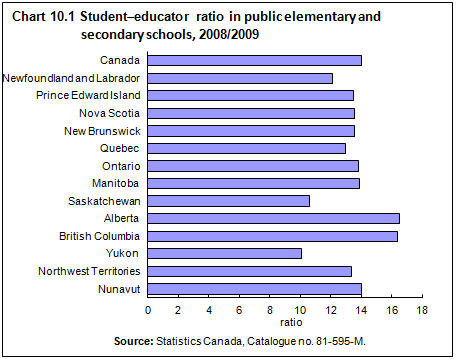Education, training and learning
Archived Content
Information identified as archived is provided for reference, research or recordkeeping purposes. It is not subject to the Government of Canada Web Standards and has not been altered or updated since it was archived. Please "contact us" to request a format other than those available.
Related information
Education, training and learning remain priorities for Canadians. In 2008, the first-time college graduation rate in Canada was 26%, well above the Organisation for Economic Co-operation and Development (OECD) average of 10%.
However, at the university level, the first-time bachelor's graduation rate was 34%, below the OECD average of 38%.
There continue to be clear benefits for university and college graduates. In 2008, the employment rate for Canadians aged 25 to 64 who had not completed high school was 58%, whereas the figure for college and university graduates was 83%. In addition, university graduates earned, on average, 75% more than high school or trade/vocational program graduates.
Not all Canadians decide to pursue formal education, however. In 2008, 20% of Canadians aged 15 to 19 were no longer enrolled in formal education. Provincially, the proportion of young people not in school varied from 14% in New Brunswick to 26% in Alberta.
Almost half (47%) of Canadians aged 18 to 64 participated in some type of education or training between July 2007 and June 2008.
Public school enrolment
Over 5.1 million students were enrolled in public schools in the academic year 2008/2009. This was down 4.9% from 2002/2003 and continued a downward trend seen every year since then.
With the exception of Alberta, all provinces experienced a decrease in their enrolment levels from 2007/2008 to 2008/2009. Prince Edward Island experienced the largest decrease, as enrolment dropped 2.3%. By comparison, enrolment in Alberta increased 0.9% in 2008/2009.
Despite declining enrolments, the number of educators (in full-time equivalents) continued to increase. In 2008/2009, there were more than 339,000 educators in Canada, up 6.8% from 2002/2003.
Enrolment in second-language immersion programs in public elementary schools and secondary schools has increased steadily since 2002/2003. Nearly 318,000 students were enrolled in a second-language immersion program in 2008/2009, a 2.1% increase from a year earlier and a 13.3% increase since 2002/2003.
Enrolment also rose for children identified with special needs. Nearly 584,000 students were identified with special needs in 2008/2009, up 7.2% since 2002/2003.
Student–educator ratio
In 2008/2009, the student–educator ratio was 14.0 students per educator. The ratio was highest in Alberta (16.5 students per educator) and lowest in Yukon (10.1 students per educator). The student–educator ratio in Canada has decreased every year since 2002/2003.
During this period, the largest increases in the number of educators at the provincial level were in Ontario (12.1%), Saskatchewan (11.7%) and Alberta (11.1%). At the same time, enrolment fell 4.4% in Ontario and 9.2% in Saskatchewan, but rose 1.7% in Alberta.
In 2007/2008, 70.8% of the educators in Canadian public schools were women, an increase of 2.8% since 2001/2002.
Education costs
The cost of education continues to rise. Total expenditure in public elementary and secondary schools averaged $11,614 per student in 2008/2009, up 8.1% from 2007/2008 and up 40.9% from 2002/2003. In 2008/2009, total expenditure per student varied across the provinces and was highest in the territories. At the provincial level, total expenditure per student ranged from a high of $12,765 in Alberta to a low of $10,210 in Prince Edward Island. The Northwest Territories had the highest expenditure per student at $22,278.
University tuition fees are continuing to rise. Full-time Canadian undergraduate students paid, on average, 4.0% more in tuition fees in 2010/2011 compared with one year earlier. That amounts to an average undergraduate tuition cost of $5,138.
Tuition fees rose in all but three provinces. Fees remained unchanged in New Brunswick and in Newfoundland and Labrador but fell 4.5% in Nova Scotia. Undergraduate students in Ontario paid the highest tuition fees ($6,307) followed by undergraduate students in New Brunswick ($5,516). Meanwhile, undergraduate students in Quebec ($2,415) and Newfoundland and Labrador ($2,624) continued to pay the lowest tuition fees.
Graduate students also faced tuition increases. On average, Canadian graduate students paid $5,182 in tuition costs in 2010/2011, a 6.6% increase over 2009/2010. Fees for graduate students were up in six provinces, ranging from an increase of 1.6% in Alberta to 10.6% in Ontario.
- Date modified:

